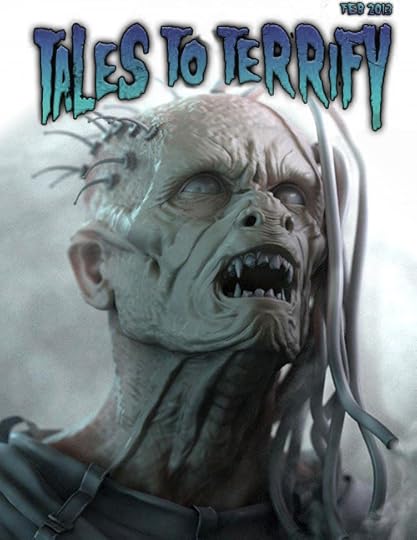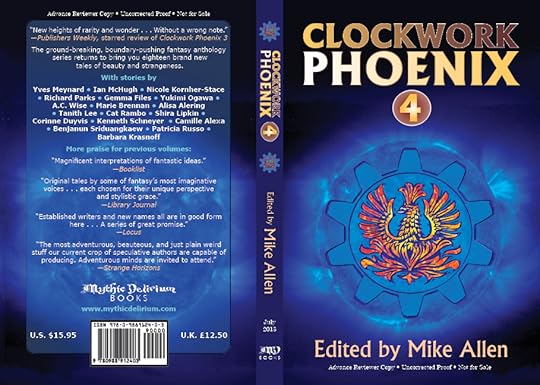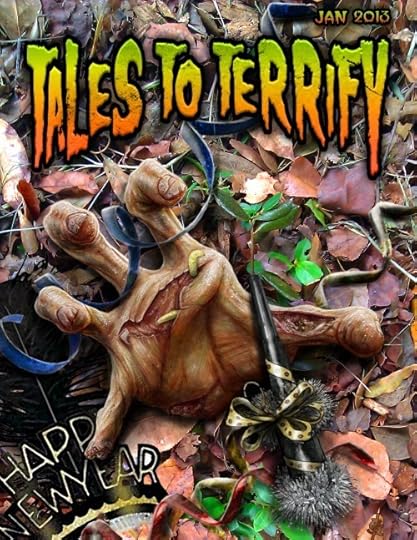Mike Allen's Blog, page 28
March 2, 2013
A 2009 essay on speculative poetry, reclaimed from the Wayback Machine
Guest Blog by Mike Allen (on the now-defunct Nebula Awards site) posted on October 05 2009
I was lucky enough to attend two award ceremonies this year related to speculative writing. First, the Nebula Awards ceremony in Los Angeles, where I got to see Harry Harrison receive his Grand Master Award, hear Janis Ian perform a filk version of one of her greatest hits, and lose the award in my category to a wonderful writer whom I’ve long admired.
Second, the Rhysling Award Poetry Reading in Boston, where I got to see young writer-to-watch Amal El-Mohtar learn she had won the award in the “short poem” category for her whimsical and musical poem about Damascus, “Song for an Ancient City.” It’s this second awards ceremony that I want to talk about at length here.
Science fiction poetry, fantastic poetry, speculative poetry, whatever you wish to call it, forms the core of a lively, thriving scene that coexists with genre fiction in many venues.
Let me show you some stills from the poetry scene.
I am the MC of the Rhysling Reading at ReaderCon, where the Science Fiction Poetry Association has announced the Rhysling winners for the past five years. This year, I talked Michael Bishop into reading his poem “For the Lady of a Physicist,” which won the “long poem” Rhysling Award in 1979. Michael delivered a charming preamble in which he explained that though his poem begins with a quote from Stephen Hawking, it’s modeled after Andrew Marvell’s “To His Coy Mistress” (the source of that oft-quoted phrase “world enough, and time”). A delighted murmur went through the 80-strong crowd. They knew the poem. The delighted reactions continued as they listened to the clever rhymes contained in his humorous poetic mash-up.
Not long after came Amal and Catherynne M. Valente, who kept the crowd rapt as they stood back to back and read alternating lines of their Rhysling nominated collaborative poem “Damascus Divides the Lovers by Zero, or the City is Never Finished.” A number of new talents and veterans took their turns, with Julia Rios, Caitlyn Paxson, Lila Garrott and others giving standout renditions of beautiful and complex poems, and Darrell Schweitzer amusing with a piece from Asimov’s Science Fiction that was short and off the wall. I’ve given away the ending: Rhysling Award Chairman Drew Morse passed on reading a poem of his own to announce the winners and spring the news on Amal that the members of the SFPA had voted her poem in the short category the winner by a landslide.
The long category went to “Search,” a nostalgic and funny look at the hunt for alien life by multiple Hugo and Nebula winner (and previous Rhysling winner) Geoffrey Landis. And I was pleased as punch that Michael approached me after the reading to tell me how delighted he was by the poetry he’d heard during that hour.
I couldn’t help but feel I’d been party to one of science fiction poetry’s proudest moments. Though that’s hardly been the only one of late. Roll back a year to August ‘08 when Drew, SFPA President Deborah P Kolodji and Treasurer Samantha Henderson went to Ray Bradbury’s birthday bash at Mystery and Imagination Bookstore in Glendale, CA, to present him with the Grand Master Award for achievement in speculative poetry. The meeting is recorded on video. Clearly delighted, Bradbury gives an impromptu speech about how he envied the talented poets he knew in his youth and the consternation he felt when Aldous Huxley informed him he was indeed a poet. Debbie tells Bradbury, “We think you’re a poet, too.” Grinning, Bradbury poses with the trophy, then exclaims, “To hell with the Academy Award!”
The past few years have seen a number of these memorable moments. The first Rhysling Award Reading at ReaderCon, where Joe Haldeman received a standing ovation for his reading of his rhyming double sestina, “Old Twentieth: a century full of years.” The 2008 Eaton Conference at University of California Riverside, in which the entirety of the SFPA’s archive of print publications going back to 1978 was made part of the J. Lloyd Eaton Collection of Science Fiction, Fantasy, Horror and Utopian Literature. Debbie’s talk on speculative haiku for the Haiku North America conference in the National Archives of Canada. Heck, even the room party held at ReaderCon by Amal and her co-editor Jessica Wick to launch the newest issue of their poetry zine Goblin Fruit was packed, with just about every personage of note at the con that night stopping in to chat.
The fact is, right now, speculative poetry is alive and well and interesting as hell. Though you might not realize it if you relied solely on the critical writings about sf, these explorations of science fiction, fantasy, horror and stranger themes in verse can be found in most of the same places short fiction is found, whether in print or online. Even occasionally in an anthology or two. Sometimes even a “best of the year” anthology.
It’s a form of writing kept alive by writers and editors who are just as interested in using poetry forms to examine the themes of speculative literature as they are in using prose. Its perpetuation is certainly a labor of love—not too different in its way from the dedication in absence of financial reward that goes into producing a number of the prominent semi-pro publications or even (by SFWA standards) professional short fiction venues. Like those venues, the field of sf poetry has been a proving ground for upcoming talents (the list of Rhysling Award winners yields such names through the years as Susan Palwick, Jeff VanderMeer, Theodora Goss, Tim Pratt, Catherynne M. Valente) and also a place where established veterans like Bishop or Landis or Joe Haldeman or Jane Yolen might turn up to make art that’s a little off the beaten track.
Most of the time, though not always, the poems also function as little narratives or mini-fictions (or in the case of the sf or fantasy haiku, mini-mini-fictions. In fact the folks who write such things have for years been producing the equivalent of the Twitterfic one now finds at Internet hotspots like Thaumatrope.)
There are currents and countercurrents to be found inside this scene. As a not-exactly neutral observer, I might break things down like this. Asimov’s, the monolithic source of the best and highest profile sf poetry through the ‘80s and ‘90s, has been eclipsed as the prime pillar of speculative poetry with the rise of the Web zines, which could shed the limits on length and theme that come with squeezing works into leftover space on the printed page. Strange Horizons, with its collection of co-editors with deep roots in the field, is the inheritor of sf poetry’s mainstream, the poems there following an overall sensibility directly descended from the poetic experimentations in the ‘70s of the likes of Ursula K. Le Guin, Thomas M. Disch and Brian Aldiss. A newer movement centers around the aforementioned upstart Goblin Fruit, with its focus on fantasy, myth and folktale inspired by Terri Windling and Midori Snyder’s late lamented Journal of the Mythic Arts. (Mind you, it would not be difficult to find individual exceptions to my sweeping generalizations at any of these markets, or, for that matter, poets who publish with frequency in all three places.)
If you’ve made it this far with me, you might be wondering when I’m going to tell you about what science fiction poetry is, or how you write it. Frankly, what it is, you’ve probably deduced by now, and if you want to know how to write it, your best bet is to go to some of these places I’ve mentioned already and start reading (or even to other places, like the decades-old zines Dreams & Nightmares, The Magazine of Speculative Poetry and Star*Line, my own zine Mythic Delirium, Astropoetica, Abyss & Apex, Ideomancer, Sybil’s Garage, Lady Churchill’s Rosebud Wristlet, Electric Velocipede … this list could get ludicrously long if I’m not careful.)
Many essays I’ve read about speculative poetry start with an attempt to explain just what this strange and wonderful chocolate-in-the-peanut-butter style of writing is, with sheepish asides about how little money is involved in writing it. To my mind, that approach wrestles with the obvious and misses out on the fun.
So I wanted to take a different tack, and just let you know that here in the universe of speculative poetry, we’re having a heck of a party, and we’d love for you to join us.
February 28, 2013
The first review of CLOCKWORK PHOENIX 4
Over the past two weeks, I’ve begun sending out advance reviewer copies of Clockwork Phoenix 4. As it shakes out, Lois Tilton of Locus Online ends up having the first word on my Kickstarted anthology, turning around a review more or less immediately (click here to go read.)
She notes that this is her first-ever crack at one of the Clockwork Phoenix anthologies and says, in part:
a rare original anthology … takes best of show this time. … The tone ranges from dark to heartwarming and simple. The overall quality is high … Several of the pieces are quite challenging. Readers will do well to pick up a copy.
Kenneth Schneyer’s “Selected Program Notes from the Retrospective Exhibition of Theresa Rosenberg Latimer” not only receives a “Recommended” rating, but also her “Good Story Award,” the only one she declared in February. She calls it “A piece that rewards re-reading.”
She also gives a “Recommended” to Nicole Kornher-Stace’s “On the Leitmotif of the Trickster Constellation in Northern Hemispheric Star Charts, Post-Apocalypse.” (Yay, long titles!) She calls it “A fascinating puzzle of a fiction.”
She also offers particular lauds to stories by Ian McHugh, Richard Parks, Gemma Files, Tanith Lee, Corinne Duyvis, Benjanun Sriduangkaew and Patricia Russo, and, notably, has very little that’s critical to say about the stories she didn’t actively praise.
Because it’s not clear from the review, I feel the need to clarify: Lois read an uncorrected proof, provided to her just two weeks ago. (That is one spectacular turnaround time.)
However, the anthology will not be publicly available for sale until July. (The others, of course, can all be had now.) Ideally, Kickstarter backers will receive their e-book and/or trade paperback copies in May/June, assuming I can keep the schedule on course. Regardless, by then it will have been proofread.
Perhaps it’s worth mentioning that I still have a few trade paperback ARCs left if there’s a reviewer out there who’s interested.
February 10, 2013
February Tour of the Abattoir at Tales to Terrify
This post is a little late, but then that tricksy Larry Santoro ran my column a little early! Regardless, there’s a new “Tour of the Abattoir” up at Tales to Terrify, in which Shalon Hurlbert and I talk about Let the Right One In in all its incarnations.
Next up, Mama, and some things I’ve been reading.
What I’ve been working on
January 31, 2013
Speculative poetry editors make Best of 2012 recommendations
Writer and editor Rose Lemberg today posted a round-up of a weeklong project she organized in which editors of speculative poetry publications listed their top five favorite poems published in 2012 by venues other than their own.
Individual recommendations come from Amal El-Mohtar (Goblin Fruit,) Romie Scott (Strange Horizons,) Mitchell Hart (Through the Gate,) Samantha Henderson (Inkscrawl,) Rose Lemberg (Stone Telling,) Adrienne J. Odasso (Strange Horizons,) Alexa Seidel (Niteblade) and Erzebet YellowBoy (Cabinet des Fées.) Reviewer Bogi Takács of prezzey.net also made a list of recommendations.
I hope you’ll all follow the links and make new discoveries.
(Full disclosure, because a few have asked: I was invited to participate but couldn’t carve out enough time from my other projects to do the reading I felt would be necessary to make informed recommendations. I’m grateful that a couple of my poems received nods, and three poems from Mythic Delirium also received mentions. To see which ones, you’ll have to go read.)
January 22, 2013
Picking the Clockwork Phoenix 4 stories: The Process (part 2)
I’m back with part two of my explanation of the Clockwork Phoenix 4 submission process, this time breaking down the most crucial piece of the process: what happens while the submission window is open. (Part One can be found here.)
There’s all sorts of misconceptions out there about how short story slush reading works. I’m pretty sure the way I handle it is close to how most pro and semi-pro outfits do things, so hopefully elucidating will be helpful all around.
Here’s metaphor #4. A story submission essentially works like an audition for a part in a play. I think some writers lose sight of this aspect, because sending in an e-mail and waiting for a response feels much more impersonal than waiting to be called in front of the director to start your monologue or demonstrate your dance skills.
And yet, that’s exactly what’s happening. Your story is your performance. And in the case of Clockwork Phoenix, I’m the director.
A side note: I saw an appalling number of cover letters that included attempts to summarize and/or pitch the story. I’m not sure where folks are getting the idea they’re supposed to do this. You shouldn’t. It’s not professional. It makes sense with novels, where you’re pitching agents or editors in hopes of getting them to ask for a copy to read, or with non-fiction projects, where you’re pitching something you haven’t actually written yet … but for short stories, it makes no sense at all. What you’re doing is giving the editor a chance to reject your story without ever looking at it. And it’s not necessary. All short story markets are going to judge your submission based on the strength of your first paragraph and then what follows. There’s no need to include a pitch. Just stick to your credentials. If you don’t have credentials, be brief and polite. Be brief and polite even if you do have credentials, for that matter.
Back to the main event: it really is all about your first paragraph. If you start your monologue and what you say isn’t interesting — and there’s hundreds of people waiting in line behind you — then I have to wave you off the stage and let the next person have their turn. If you start your monologue and what you’re performing is an obviously bad fit for the show I’m trying to put together, in style or subject matter, same deal. There’s no time and no room for something that doesn’t rivet me from the outset. That doesn’t mean you have to start with an explosion. It means you have to start in a way that immediately makes me want to know more. If I don’t care what happens next, I assume my readers won’t either.
And here’s why writing is so hard. Hooking my attention at the start isn’t enough. You have to keep it up, page after page, providing new hooks, new intrigues. Keep me engaged. If my attention wanders, I’ll wave you off the stage and it’s the next person’s turn.
This, frankly, is how you manage a flood of more than 1,000 submissions in two months. Most stories never make it past the first two stages in the audition. That story has to engage me, again and again, all the way to the end. And then the ending itself has to impress. If you pull that off, and not very many do, then I can start thinking about whether you might actually fit in with the rest of the cast.
(I’m not unsympathetic, mind you. I’m a veteran of many failed auditions myself.)
In practical terms, though, the system has to be this mercilessly efficient. And I feel it’s my duty to writers to reject their stories as soon as I’m sure I won’t be using them, so they can start shopping them elsewhere.
This year, I had three assistants, Sally Brackett Robertson, Sabrina West, and Anita, whose much bigger role involves figuring out the shape of the finished book but also sometimes helps with slush. I looked at the majority of submissions personally; this makes sense, as no one can figure out whether I want or don’t want something faster than me. Sabrina and Sally had instructions to err on the side of passing a story up for me to review if they had any questions as to whether it might fit. If they were certain it wouldn’t fit, of course, they were free to turn the story down. Their help was essential for keeping the book on schedule, and I’m really grateful they volunteered.
About a week after the submission window closed mid-December, I’d winnowed the stories down to the list of finalists. When it comes to assembling an anthology, I always consider this phase the most difficult part. Inevitably, there will be stories that I really, really liked that I’m ultimately going to have to send home in order to keep the book within budget; so I have to take a hard look at what stories work best together, the elements each one brings to the mix, and which ones perhaps don’t quite fit the mix. And then I have to write those sad, sad rejections. Again, I’m not without sympathy. I’ve been on the receiving end of my share.
And, finally, as proof that there’s wiggle room even among the top tier, several of the finalists weren’t accepted until after I’d requested the writers consider some tweaks. (This has been the case for all four volumes.)
With Clockwork Phoenix 2 and Clockwork Phoenix 3, when I’d finished all the winnowing, Anita and I both ended up feeling that we hadn’t quite gotten the balance right — usually because of a shortage of that “rococo sf” we covet — and in both instances I wound up soliciting additional stories after the window closed.
One benefit of having so many submissions: that did not happen with Clockwork Phoenix 4. Again, I’m very pleased with the mix that came together. Hopefully all of you will be too.
One last, admittedly peevish thing that I want to point out. Every time I’ve put together one of these books, at least one person complains about not being able to figure out what I want. It’s poor form to lash out at an editor (and seriously poor form to lash out at an editor’s assistant!) anyway — to go back to my audition metaphor, it’s not as if there aren’t also hundreds of people in line with you, almost all of whom have no trouble conducting themselves professionally from start to finish. And so someone who responds to a rejection with an angry note stands out as even more of a jerk than he probably realizes.
But I just want to point out to those who might fume that my tastes are inscrutable: there are authors in this new book, who have never been in Clockwork Phoenix before, who set out to write something with my tastes in mind, and flat out nailed that target. That bar I set? They floated over it. So, it can be done. I’ve got unassailable proof.
Reading the anthologies helps, of course. And now there’s going to be one more to read.
Which is really what’s most important.
January 21, 2013
Picking the Clockwork Phoenix 4 stories: The Process (part 1)
I’ve split this long, long post about the inner workings of the Clockwork Phoenix 4 submission process in twain in an attempt to make it more digestible. Part Two will appear tomorrow. (Click link to read.)
When announcing the Dark Faith: Invocations table of contents, Jerry Gordon put up a post explaining the process involved in selecting the stories. Based on his example, I thought it might of interest, and perhaps even educational, if I offered the same information for Clockwork Phoenix 4.
So how do you get from more than 1,400 submissions down to a final lineup of 18 stories?
I’ll share the brutal truth. But first, a preamble or two.
During the Kickstarter campaign, I received a couple of mild half-joking protests from would-be contributors when I set the $8,000 stretch goal to pursue paying pro rates for stories. The protests could be paraphrased as, “My odds will be better if you don’t pay pro rates.” Which is a bit of a misconception, as I’ll explain presently.
Also, as the opening of the submission window approached, I received an occasional note from some very confident writers along the lines of, “Hey, I’m gonna have a story for you!” My general response was the Internet equivalent of smiling, nodding politely, and saying that I looked forward to checking it out, all the while thinking, Well, so will 1,000 others…. Which proved to be an underestimation. But that confidence falls into the same sort of trap as those thinking about the submission pile in terms of odds.
As editor of the previous three volumes of the series, I have built-in standards in place about the type of subject matter I want to see, the styles I find acceptable, the sort of stories and ideas we’ve showcased previously and don’t need to repeat, and in addition to those things, there’s the harder to quantify matter of whether a story can hold my attention from start to finish and deliver on all its promises by the end. So to offer the first two metaphors of this diatribe, it’s as if I have set a really high pole vault bar that your story must then clear, or propped up an archery target that your story must then peg dead center, splitting the arrows already there a la Robin Hood — and only after you’ve hit that bulls-eye or cleared that jump do you have a shot at actually being included in the book.
So there’s nothing, really, left up to chance, and no one is guaranteed a place.
The fact is, over the course of the submission process, there were maybe somewhere between 30 and 40 stories out of that 1,400 plus that were seriously in the running to be in the book.
You can accurately conclude that the overwhelming majority of submissions did not clear the bar or hit the mark. Within that broad swath there’s a wide range — from those that missed by centimeters to those disqualified on the starting blocks. I’d say most of the stories at least hit the target somewhere and/or landed safely on the mat. (These things were just as true with the previous three volumes.)
There were quite a few in the upper range who executed their leaps and loosed their arrows with perfect form, but whiffed because, though their stories were absolutely publishable — as with previous volumes, it would not at all surprise me to see some of these tales find homes in other, more prestigious venues — thematically and stylistically, the stories weren’t a perfect match for my book. I’d consider the highest range those who did send in stories that fit, but for whatever reason, the story itself didn’t work for me.
So why hold a submission window if so few stories are going to clear the bar? Because I don’t know who’s out there in the whole wide world who might well have written a story that’s exactly what I want, and the only way I’m going to know is if I toss out the nets and let the stories swim in for inspection. (Metaphor #3.) Of our 18, I ended up with eight authors who are alumni of previous volumes, ten who are new to the series and four who are completely new to me. I’m pleased with that ratio.
So, having given that overview and exposed that cruel truth, let me explain the mechanics involved. I suspect this is very similar to what happens at most fiction markets.
First, before the submission window opened, I invited the contributors to the previous volumes and a few other writers whose work I was familiar with to submit. You might think, A-ha! That’s why there’s so many alums! — but actually, that’s not why it shook out that way. Because of the breakneck pace of the anthology, only a handful were able to take advantage of that opportunity and submit early, and of those stories, only one made it into the final lineup, after the author carried out an extensive rewrite request I made. All the rest came in during the submission window.
As I’ve explained, making the final round was all about hitting the target dead center. It makes sense that those who I’ve previously published would have better instincts for what I look for; but there were also an equal number of alums who sent in work and missed the final cut, or were ultimately culled from the list of finalists.
But I’m getting ahead of myself. I’ve now reached the most important part, which I’m going to talk about in the second installment — the management of the submission window.
New reviews of my e-book short stories
My thanks to Willian D. “Dusty” Wallace (known here in Roanoke as the man behind the Dusty on Movies blog) who checked out my three short stories available on Amazon as e-books and wrote a review for each one. Generously, all are five-star.
I share snippets from each:
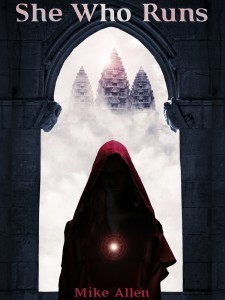
She Who Runs
For a short story this feels big. The main events are influenced by ages of cosmic unrest that came before and the story progresses eons into the future. In context it’s awe-inspiring and never seems like it’s cutting corners to maintain its status as a short story.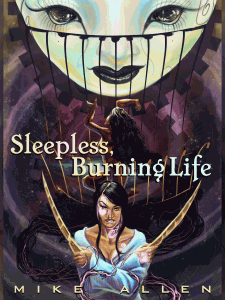
Sleepless, Burning Life
This story portrays a tangible creation myth that’s inhabited by headless men, mechanical objects and lesbian goddesses. Personally, I’m ready to attend mass at that cathedral … Beautifully written, erotic, imaginative and with a host of alternate endings built in.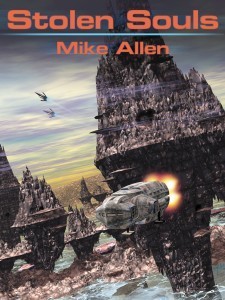
Stolen Souls
This is really about a detective who can’t cope with the murder of his beloved and ends up flying off the rails in a selfish attempt to right the wrong. By the end of the story the author is working in a realm of pure imagination but it never gets confusing. This is a winner that you’ll read to the end in one sitting.
January 18, 2013
A new “Tour of the Abattoir” at Tales to Terrify
In which I discuss the novel This Book Is Full of Spiders and the movie John Dies at the End. Our main feature is a reading of “The Gaze Dogs of Nine Waterfall” by Kaaron Warren.
January 17, 2013
Winter storm bonus: best photo of my house ever
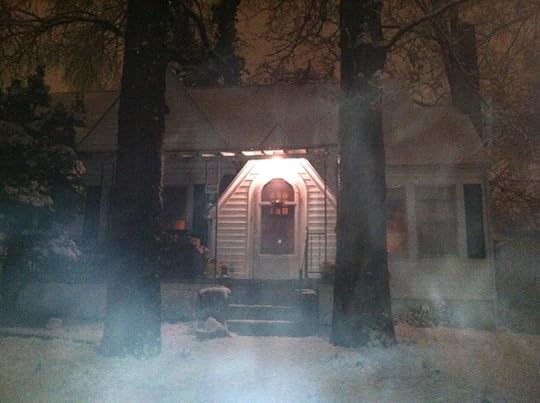
My own ghostly winter wonderland.

